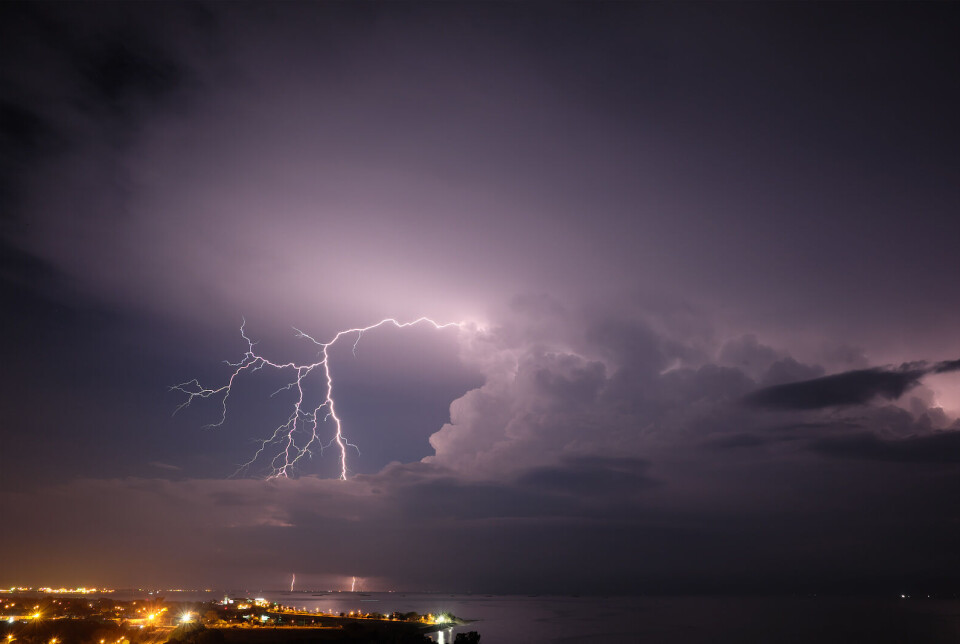
Norwegian researchers with a new discovery:
This thunderstorm bubbles and boils with radioactive radiation
“There’s much more than we previously thought,” says a Norwegian researcher.
Thunderstorms can be intense, with booming thunder and flashes of lightning that leave an imprint on your vision.
However, much more occurs that you can’t see, hear, or perceive. Other hidden phenomena are present in thunderclouds, and our senses are not equipped to detect them.
It has long been known that thunderstorms can emit gamma rays – light particles with extremely high energy. These emissions have been measured with instruments aboard the International Space Station for many years, and they were first detected in the 1990s.
Gamma rays are the most energetic form of electromagnetic radiation. They are emitted during violent events such as exploding stars, atomic bomb detonations, and gamma-ray bursts from space.
And thunderstorms are no exception.

Norwegian researchers got close to the thunderclouds
Researchers at the University of Bergen have now investigated massive tropical thunderstorms in a completely new way – by observing from above but much closer than space allows, using airplanes.
“Flying at an altitude of 20 kilometres, we get so close that we can see things that were invisible from space,” Nikolai Østgaard tells sciencenorway.no.
Most viewed
He is a professor at the University of Bergen’s Department of Physics and Technology.
The researchers have discovered new radiation phenomena, which last longer than previously thought.
For example, they observed gamma radiation bubbling within the clouds, increasing dramatically in intensity before quickly vanishing – possibly because this is closely linked to lightning.
The researchers describe the radiation as "bubbling cauldrons" of gamma radiation, similar to what you can see in the illustration of the plane flying above the clouds.
According to the recent studies, this gamma glow lasts much longer and spans a much larger area than previously thought.
“The clouds glow with low-intensity gamma radiation. We took measurements over a storm that bubbled for three hours, continuously as we measured,” says Østgaard.
Together with colleague Martino Marisaldi, Østgaard detailed these brand-new observations of tropical thunderclouds in two recent Nature articles.
These measurements were made using a variant of the U-2 spy plane, called ER-2, operated by NASA.
This plane can fly at extremely high altitudes, enabling it to collect data high above large thunderclouds over the Gulf of Mexico and Florida, which reached over 17 kilometres high. By comparison, commercial aircraft fly at around 10 kilometres above sea level.
100 times more frequent than previously thought
Intense, short-lived bursts of gamma radiation occur much more frequently than previously thought, according to the new studies.
Earlier estimates suggested one gamma-ray burst occurred for every 10,000 lightning strikes, based on measurements from space, Østgaard explains.
However, the new data shows that gamma bursts happen at least one hundred times more often, making powerful gamma-ray flashes a regular part of thunderstorms.
“This is part of the breakthrough. These phenomena were once considered rare and exotic,” he says.

But this may happen with every tenth or hundredth lightning strike, which is several orders of magnitude more frequent than previously thought, according to Østgaard.
And since this is radioactive gamma radiation, it would not be healthy to be exposed to large amounts. The researchers estimate that a single flash is equivalent to a full-body X-ray, but you would need to be in a plane above the cloud to be exposed to it.
So how do tropical thunderclouds create gamma radiation?
Like a particle accelerator
Inside thunderclouds, extremely powerful electric fields form. These are the fields that discharge during a lightning strike.
These electric fields also act as natural particle accelerators. Electrons that enter these fields are accelerated to incredible speeds, nearing the speed of light.
When these electrons collide with water, nitrogen, and oxygen in the clouds, the collisions are so energetic that they emit light particles at the highest possible energy: gamma radiation.
This radiation spreads through the cloud, creating more gamma rays – and even gamma rays from antimatter, which forms and vanishes due to the energy in these collisions.
“It’s expected that antimatter is created here, but it’s still surprising to see the measurements,” says Østgaard.

Radiation peaks followed by lightning
Exotic antimatter is produced in small quantities by humans at the LHC particle accelerator at CERN in Switzerland, due to the high energy levels involved. You can read more about the long search to understand how gravity affects antimatter here.
In the past, both gamma radiation glows from thunderstorms and intense, short-lived bursts of gamma radiation, known as terrestrial gamma flashes, have been observed.
The new data reveals clearer patterns and give a better understanding of how often and when these flashes occur. Initially, the gamma rays glow with much lower intensity in the clouds.
“It bubbles, with each bubble lasting about five to ten seconds,” says Østgaard.
Inside these bubbles, there are intense radiation peaks, though they are brief. Some of these peaks appear as pulsing bursts, a phenomenon recently described by researchers as flickering gamma-ray flashes.
“Shortly after these radiation peaks, we observed intense lightning activity,” he says.
The new research does not explore the exact connection between these events or the role they play in lightning formation within clouds.
Uncertain if this also applies to thunderclouds in Norway
The next question is whether the gamma radiation glow ceases in the same area where the lightning occurs, only to be replaced by new bubbles forming inside the cloud, building up more gamma radiation.
“Lightning is an electric discharge that reduces the electric field, so the glow might stop in that area afterwards,” he says.
Østgaard explains that this is a question that needs to be explored in other ways, possibly with the help of special gamma cameras mounted on the NASA aircraft.
He mentions the hypothesis that these bubbles form in different areas of the cloud and disappear after lightning strikes, but there is no data yet on exactly where this happens – only observations over time.
It is also uncertain if the same thing happens in thunderclouds in our part of the world. Tropical storms are much larger and taller, so it is unclear if the smaller storms here would behave the same way. No one has studied this yet, says Østgaard.
He believes it could happen here as well, but likely as a rarer phenomenon.
A piece of the puzzle
Meteorologist Alexander Skeltvedt from the Norwegian Meteorological Institute has previously specialised in lightning, and he is impressed by the new studies. He did not participate in the research.
“This has been a long journey, with researchers working for at least 20 years to uncover the full story. Where this was once thought to be a rare, isolated phenomenon, researchers have managed to track it over time,” he tells sciencenorway.no.
He highlights this is a prime example of how modelling and theory are tested and verified through investigations.
“And now they’ve found the puzzle piece that ties all the phenomena together,” he says.
Skeltvedt also notes that improved instruments on aircraft could help uncover even more of what is happening in these storms.
“They haven’t discussed the production mechanisms much, but that might be difficult to measure,” he says.
American physicist Joseph Dwyer from the University of New Hampshire has commented on the research in Nature, highlighting that these findings not only show how the different phenomena are connected, but also suggest potential implications for how lightning actually forms inside clouds.
References:
Marisaldi et al. Highly dynamic gamma-ray emissions are common in tropical thunderclouds. Nature, 2024. DOI: 10.1038/s41586-024-07936-6
Østgaard et al. Flickering gamma-ray flashes, the missing link between gamma glows and TGFs. Nature, 2024. DOI: 10.1038/s41586-024-07893-0
———
Translated by Alette Bjordal Gjellesvik
Read the Norwegian version of this article on forskning.no

Subscribe to our newsletter
The latest news from Science Norway, sent twice a week and completely free.



































